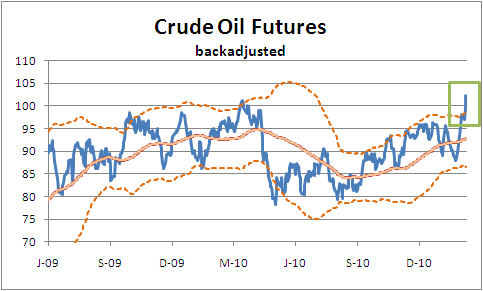At the risk of being one of those people who throws a bunch of lines, arrows, and squares on a chart and says… look at this…we have re-created a chart of Crude Oil over the past 20 months to highlight how a classic trend following trade looks.
While there are hundreds of different ways to do trend following, the general idea is to bracket the market with volatility adjusted bands, and when the market ‘breaks out’ above those bands, go long – when breaking out below the lower band – go short.
We have used rather standard 80 day averages and standard deviation lookbacks to create the bands in the chart below, showing that Crude Oil broke out to the upside on 2/23. The classic trend following trade is to go long on the open following that breakout, which was last Thursday’s open of 98.97, and risk down to the 60-100 day moving average. In our example, we’re using the 80 day moving average (the lighter orange line), which sat $6.57 away from the entry at 92.41 on 2/24, representing $6,570 of risk on the entry day.

Moving forward, the classic trend following model hopes prices will remain above the moving average long enough to pull that average above the entry price, thereby locking in a gain. If prices fall and the moving average doesn’t advance, the trade will lose the difference between the entry and wherever the moving average is at the time prices close back below it.
To see why and how trend following, and managed futures in general, are long volatility strategies where profits can be many times the amount risked on a trade – one only need imagine Crude Oil going to $150 on the back of an uprising in Saudi Arabia or something. In such a case, the trade could make $50+ ($50,000) on the same initial risk of just $6,500, for a risk/reward payoff of nearly 8 to 1. Conversely, if peace spreads across the Middle East over the next few weeks by some chance and Crude Oil sells of $50 down to $40 something, you still only lose the $6,500 (ignoring slippage and the possibility you could be locked limit down and unable to get out).
This ability to make a great deal more than you risk when volatility explodes is the classic trend following model’s calling card. The downsides, 1. only a small percentage of such breakouts may succeed and 2. Crude may go up to $140, and then all the way back down to $110, making for an overall gain, but causing pain in that your account will have given back $30 of open trade profits.
No comments:
Post a Comment